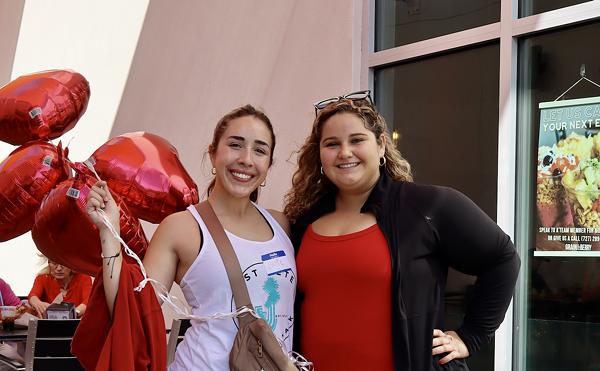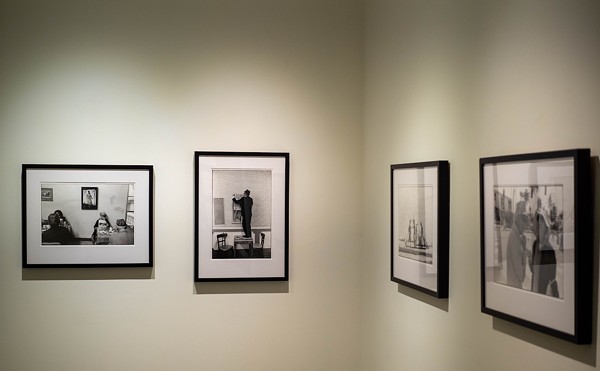Vision is often cited as the quintessential quality of a great leader. “Hindsight Is Always 20/20,” an artwork by R. Luke DuBois, puts that idea in crisply legible perspective. To create the piece, DuBois culled the 66 most frequently used words from the State of the Union addresses of each U.S. president from George Washington through George W. Bush, then arranged them, with the aid of a professional graphic designer, into letterpress prints in the style of Snellen eye charts. (DEFPOTEC, anyone? If you can read that line on a Snellen chart, your visual acuity is 20/20.)
While it may be predictable to see the word “TERROR” glaring out in block letters from G.W. Bush’s chart, the effect remains chilling. Finding “Iraq,” “Iraqi,” “terrorist” and “Al Qaida” on the lines below may transport some viewers back to the days, and the rhetorical haze, that followed 9/11. Contrast illuminates context in DuBois’ work. For instance, Bill Clinton’s comparatively peaceful regime yields words including “21st,” “affordable” and “coverage” — which evokes his failure to launch national healthcare, rather than success — while “deficits,” “bless” and “dreams” recall an era of Reaganomics.
Lincoln’s top concern (by DuBois’ metric)? Emancipation. Hoover’s? Unemployment.
Get “Hindsight,” and you’ll get the logic of DuBois’ work in general — the 38-year-old artist is known for multimedia projects that analyze and visualize data related to our sense of individual and collective identity, offering up unexpected and sometimes disturbing insights about technology and culture in the process. Through May 4, the Ringling Museum of Art plays host to his first solo exhibition in a museum, which features more than a dozen of DuBois’ projects in video, software, data visualization and music compositions, as well as opportunities to witness his collaborative performance work — the latter presented as part of a 92-day experimental arts festival called nowHERE that runs in tandem with the museum show. Not every project sings like “Hindsight,” a commission for the 2008 Democratic Convention in Denver — it’s probably the best thing DuBois has made so far — but the exhibition is fascinating.
The funniest work, “A More Perfect Union” (2010-2011), operates on the same principle of psychic mapping through data. DuBois conceived it after breaking up with a girlfriend and facing the prospect of online dating. Turning the endeavor into an art affair, he joined websites like Match.com and eHarmony and downloaded 19 million user profiles, then tabulated frequently used words and diagrammed them onto maps of U.S. cities and states.
More so than “Hindsight,” the results are comic, though occasionally aspiring to offer deeper insights. New York City’s top term, “Now,” lends the exhibition its title and echoes the popular image of the city as a fast-paced whirl of people on the make. (Granted, you’ll never hear anyone talk about a “Minneapolis minute,” and there’s a reason why.) Other cites fare less romantically: Los Angeles coughs up “acting” and “vegetarian,” while Providence, Rhode Island, seems content with “nice.” Tampa Bay, I’m sorry — but, again, not surprised — to report that your words include “dieting,” “grouper” and “tiki.” (Lay off the grouper already, fatsos! Just kidding, I love you.)
If you begin to wonder at some point whether DuBois might be having a bit of fun at a viewer’s expense with his elegant presentations of meaning filtered from data, I think you should. After they surprise and amuse, and are fun to look at — to varying degrees — DuBois’ projects leave a viewer with unsettling questions about how statistical knowledge is generated, what kinds of information is gathered by whom about whom and why, and how “big data” is increasingly deployed to create representations — portraits — of each and every one of us for use by government and corporations.
On the lighter side, the exhibition includes a series of high-definition videos produced by DuBois in collaboration with Circus Sarasota, a school and performance troupe dedicated to preserving Sarasota’s historic circus tradition. The videos depict a handful of performers “styling,” or showing off their signature moves, against jet-black backgrounds and gold titles that proclaim their names and talents in the style of circus posters.
Like another performance documentation by DuBois on display — “Fashionably Late for the Relationship” (2007-2008), which condenses fellow artist Lián Amaris Sifuentes’ 72-hour enactment of preparing for a date inside a temporary structure in New York’s Union Square down to 72 minutes — the Sarasota videos seal a moment of live performance into a mediated format that is uncannily lifelike and artificial at the same time.
Other pieces in the show just don’t work for me. A skillfully animated montage of found videos of Britney Spears, whose head appears to remain more or less static while her body morphs continuously, feels like a one-liner. Stronger conceptually, DuBois' 76-minute arrangement of Oscars Best Picture winners — each condensed to one minute of picture and sound — is instructive (look how film conventions have changed) but not fun to watch; I’d rather spend an hour with Christian Marclay’s “The Clock,” which yields some of the same insights … and pleasure. The same applies to a brilliant portrait of Google founders Sergey Brin and Larry Page that DuBois created at the request of the National Portrait Gallery in Washington. It fuses video images of the two men culled from YouTube, which Google owns, and graphic representations of continuous Google searches based on what they are saying in the videos. But it’s boring to watch. As DuBois de- and reconstructs the technological zeitgeist, he dreams up projects that are conceptually impressive for the most part, but their geek aesthetic is not engaging enough in visual terms for most viewers.
By my estimation, that’s a reasonable place for an artist to be on the occasion of his first museum solo show.
Don’t miss the remaining events slated to show off DuBois’ long-standing collaborations with other performers and musicians. On March 20, violinist Todd Reynolds will perform DuBois’ music composition “Moments of Inertia,” while on May 20, Bora Yoon and DuBois will enact ( (( PHONATION )) ), featuring Yoon’s voice and sound-making with video projections by DuBois. And on March 21 and 22, DuBois and Ringling curator Matthew McLendon will be joined by guest artists and curators to discuss making and exhibiting art in the “post-genre” world of now.
Through May 4 at Ringling Museum of Art, 5401 Bay Shore Road, Sarasota, 941-359-5700, ringling.org.















